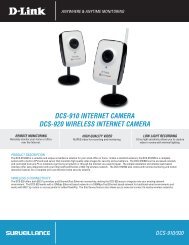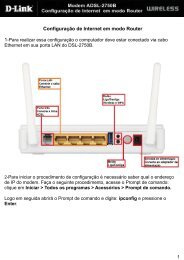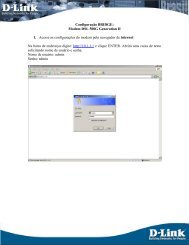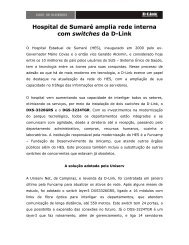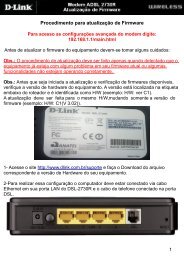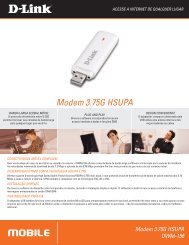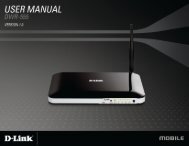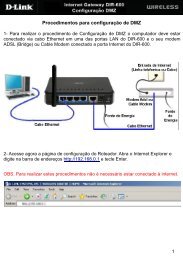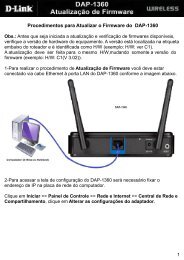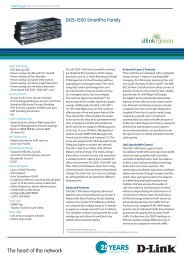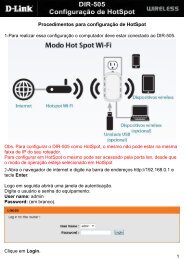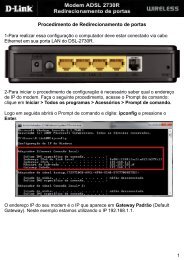Why D-Link Wireless
Why D-Link Wireless
Why D-Link Wireless
Create successful ePaper yourself
Turn your PDF publications into a flip-book with our unique Google optimized e-Paper software.
Table of ContentsProduct Overview........................................................3Package Contents....................................................3System Requirements..............................................3Introduction..............................................................4Features................................................................... 5Hardware Overview..................................................6Installation....................................................................7Getting Started.........................................................7Remove Existing Installations............................ 7Disable Other <strong>Wireless</strong> Adapters....................... 8<strong>Wireless</strong> Installation Considerations...................... 10Adapter Installation................................................11Configuration..............................................................17D-<strong>Link</strong> <strong>Wireless</strong> Connection Manager.................... 17<strong>Wireless</strong> Networks............................................ 18Wi-Fi Protected Setup (WPS)........................... 19My <strong>Wireless</strong> Networks...................................... 23Add Profile................................................... 24Modify Profile............................................... 25Support.............................................................26About................................................................27Connect to a <strong>Wireless</strong> Network................................28Using Windows ® 7..................................................28Using Windows Vista ®.......................................................................... . 30Using Windows ® XP...............................................32Table of Contents<strong>Wireless</strong> Security.......................................................33What is WPA?........................................................33Configure WPA/WPA2 Passphrase....................... 34Using the D-<strong>Link</strong> <strong>Wireless</strong> ConnectionManager...........................................................34Using Windows ® Vista/Windows ® 7................. 36Using the Windows ® XP Utility......................... 38Configure WPA/WPA2 (RADIUS).......................... 40Using the D-<strong>Link</strong> <strong>Wireless</strong> ConnectionManager...........................................................40Troubleshooting.........................................................41<strong>Wireless</strong> Basics..........................................................45<strong>Wireless</strong> Modes......................................................49Networking Basics.....................................................50Check your IP address...........................................50Windows ® XP/2000 Users................................50Windows Vista ® /Windows ® 7 Users.................. 50Statically Assign an IP address.............................. 51Windows ® XP/2000 Users................................51Windows Vista ® /Windows ® 7 Users.................. 52Technical Specifications...........................................53Warranty.....................................................................54D-<strong>Link</strong> DWA-131 User Manual2
Section 1 - Product OverviewProduct OverviewPackage Contents• D-<strong>Link</strong> DWA-131 <strong>Wireless</strong> N Nano USB Adapter• Manual and Warranty on CD• D-<strong>Link</strong> <strong>Wireless</strong> Connection Manager on CD• Quick Installation GuideSystem Requirements• A computer or laptop with an available USB 2.0 port• Windows Vista ® , 2000 (Service Pack 4) or XP (Service Pack 3) or Windows ® 7• CD-ROM Drive• 300MHz processor and at least 64MB of RAM• A 802.11n or 802.11g access point or wireless routerD-<strong>Link</strong> DWA-131 User Manual3
Section 1 - Product OverviewIntroductionThe DWA-131 <strong>Wireless</strong> N Nano USB Adapter is a convenient wireless connectivity solution for desktop or notebookPCs. Instead of stringing Ethernet cables to your PC or dismantling your desktop computer case, the DWA-131 canenable 802.11n wireless connectivity by simply utilizing your desktop or notebook PC’s USB port.Powered by <strong>Wireless</strong> N technology, the DWA-131 provides a faster wireless connection and superior reception than802.11g*. The DWA-131 is designed for greater coverage and for those that demand higher bandwidth networking.Maximize wireless performance by connecting this USB Adapter to a <strong>Wireless</strong> N router and stay connected fromvirtually anywhere in the home. This USB Adapter supports WPA and WPA2 encryption to prevent outside intrusionand protect your personal information from being exposed.D-<strong>Link</strong>’s Quick Setup Wizard guides you step-by-step through the installation process. You’ll be able to configure thisUSB Adapter without having to call the teenager from down the street to help you. The D-<strong>Link</strong> <strong>Wireless</strong> Manager isincluded with this product to keep track of all your most frequently accessed networks.Compact in size, robust in speed the DWA-131 <strong>Wireless</strong> N Nano USB Adapter is great for travel and a convenientsolution for providing high performance wireless connectivity to your desktop or notebook PC. Enjoy the many benefitsof wireless connectivity today!* Maximum wireless signal rate derived from IEEE Standard 802.11g and 802.11n specifications. Actual data throughput will vary. Network conditionsand environmental factors, including volume of network traffic, building materials and construction, and network overhead, lower actual data throughputrate. Environmental conditions will adversely affect wireless signal range.D-<strong>Link</strong> DWA-131 User Manual4
Section 1 - Product OverviewFeatures• Micro-size WLAN USB adapter for placement anywhere.• Convenience of Plug & Play installation.• Fully 802.11g compatible.• 802.11n compliant.• Powered by the USB port; no external power source required.• USB 2.0 standard * .• You can securely connect to a wireless network using WPA/WPA2 (Wi-Fi Protected Access) providing youa much higher level of security for your data and communication than has previously been available.• Position the DWA-131 almost anywhere in your workspace to achieve the best reception possible.• Supports Infrastructure networks via an access point• User-friendly configuration and diagnostic utilities.* Using a USB 1.1 port will adversely affect throughput.D-<strong>Link</strong> DWA-131 User Manual5
Section 2 - InstallationInstallationThis section will walk you through the installation process. If you have a built-in wireless adapter, please disable it indevice manager before installing your D-<strong>Link</strong> adapter. Also, if you have previously installed another wireless adapter,please make sure any software is uninstalled.Getting StartedBefore installing your new D-<strong>Link</strong> wireless adapter, please verify the following:• Remove any previous installations of wireless adapters• Disable any built-in wireless adapters• Verify the settings such as the SSID and security settings of the network(s) you want to connect toRemove Existing InstallationsIf you’ve installed a different manufacture’s adapter or a different model D-<strong>Link</strong> adapter, make sure the software isuninstalled before installing the new software. Some utilities may cause a conflict with the new software. If you planto use multiple adapters at different times, make sure the utilities are not set to load when your computer boots up.Windows ® XP users may use the built-in wireless utility for all adapters.To remove any old software:Windows ® 7 users: Click Start > Control Panel > Programs > Uninstal a ProgramsWindows ® XP/Vista ® users: Click Start > Control Panel > Add or Remove Programs.Windows ® 2000 users: Click Start > Settings > Control Panel > Add or Remove Programs.D-<strong>Link</strong> DWA-131 User Manual7
Section 2 - InstallationDisable Other <strong>Wireless</strong> AdaptersMost newer laptops may include a built-in wireless adapter. To prevent any conflicts with the D-<strong>Link</strong> wireless adapter,it is recommended to disable the wireless adapter (as well as any unused Ethernet adapters).From the desktop, right-click on the My Computer icon and selectProperties.Click the Hardware tab and then click Device Manager. Scroll downthe list and click the + sign to the left of Network Adapters.Right-click the adapter you would like to disable and selectDisable.D-<strong>Link</strong> DWA-131 User Manual8
Section 2 - InstallationClick Yes to disable the adapter.The adapter is now disabled. When disabled, a red X will bedisplayed.Disabling the adapter will not remove the drivers. If you would liketo use the adapter, simply right-click it and select Enable.D-<strong>Link</strong> DWA-131 User Manual9
Section 2 - Installation<strong>Wireless</strong> Installation ConsiderationsThe D-<strong>Link</strong> wireless adapter lets you access your network using a wireless connection from virtually anywhere withinthe operating range of your wireless network. Keep in mind, however, that the number, thickness and location ofwalls, ceilings, or other objects that the wireless signals must pass through, may limit the range. Typical ranges varydepending on the types of materials and background RF (radio frequency) noise in your home or business. The keyto maximizing wireless range is to follow these basic guidelines:1. Keep the number of walls and ceilings between the D-<strong>Link</strong> adapter and other network devices to aminimum - each wall or ceiling can reduce your adapter’s range from 3-90 feet (1-30 meters.) Positionyour devices so that the number of walls or ceilings is minimized.2. Be aware of the direct line between network devices. A wall that is 1.5 feet thick (.5 meters), at a45-degree angle appears to be almost 3 feet (1 meter) thick. At a 2-degree angle it looks over 42 feet(14 meters) thick! Position devices so that the signal will travel straight through a wall or ceiling (insteadof at an angle) for better reception.3. Building Materials make a difference. A solid metal door or aluminum studs may have a negative effect onrange. Try to position access points, wireless routers, and computers so that the signal passes throughdrywall or open doorways. Materials and objects such as glass, steel, metal, walls with insulation, water(fish tanks), mirrors, file cabinets, brick, and concrete will degrade your wireless signal.4. Keep your product away (at least 3-6 feet or 1-2 meters) from electrical devices or appliances thatgenerate RF noise.5. If you are using 2.4GHz cordless phones or X-10 (wireless products such as ceiling fans, lights, andhome security systems), your wireless connection may degrade dramatically or drop completely. Makesure your 2.4GHz phone base is as far away from your wireless devices as possible. The base transmitsa signal even if the phone in not in use.D-<strong>Link</strong> DWA-131 User Manual10
Section 2 - InstallationAdapter InstallationWarning: Do NOT install the DWA-131 USB Adapter into your computer before installing the driver softwarefrom the D-<strong>Link</strong> CD.Turn on the computer and Insert the D-<strong>Link</strong> DWA-131 Driver CD in the CD-ROM drive.If the CD Autorun function does not automatically start on your computer, go to Start > Run. In the run box type “D:\DWA131.exe” (where D: represents the drive letter of your CD-ROM drive).When the autorun screen appears, click Install Drivers.Click Install DriversD-<strong>Link</strong> DWA-131 User Manual11
Section 2 - InstallationThe InstallShield Wizard window will appear.Click NextBy default setup will install to the default location: C:\ProgramFiles\D-<strong>Link</strong>\DWA-131, where C: represents the drive letter ofyour hard drive. To install to a different location click Browseand specify the location.Click NextSelect the Program Files folder location.Click NextD-<strong>Link</strong> DWA-131 User Manual12
Section 2 - InstallationInsert the adapter into an available USB port on yourcomputer.If the Found New Hardware Wizard appears, click Cancel.Click NextThe <strong>Wireless</strong> Connection Wizard will now appear.If you want to manually connect to a wireless network, refer topage 15. The following instructions will connect you to a wirelessnetwork using Wi-Fi Protected Setup (WPS).Click NextD-<strong>Link</strong> DWA-131 User Manual13
Section 2 - InstallationPush Button Configuration (PBC)To connect to your network using the WPS push buttonconfiguration method, click the virtual button as shown in thescreenshot.Note: You may also connect to your network by pressing theWPS button on the adaper and holding for two seconds until thewizard screen comes up. Then, press the WPS button on therouter/access point to continue.Press the WPS button on your access point or wireless routerwithin 2 minutes to establish connectivity.When this screen appears, you have successfully connected toyour wireless network. Click Next to complete your setup.Click FinishD-<strong>Link</strong> DWA-131 User Manual14
Section 2 - InstallationTo manually connect to your wireless network, select Manuallyconnect to a wireless network and then click Next.Click NextEnter the network name (SSID) manually. If you enter the SSIDincorrectly, you will automatically be brought to the site surveypage. Click Scan to display the site survey page.Click NextClick the Scan button to display a list of wireless networks (sitesurvey). Click on the network name (SSID) and click Next.Click NextD-<strong>Link</strong> DWA-131 User Manual15
Section 3 - ConfigurationConfigurationThis section will show you how to configure your new D-<strong>Link</strong> wireless adapter using the D-<strong>Link</strong> Utility as well as theWindows ® XP Zero Configuration Utility and Vista WLAN Autoconfiguration.D-<strong>Link</strong> <strong>Wireless</strong> Connection ManagerThe D-<strong>Link</strong> DWA-131 uses the <strong>Wireless</strong> Connection Manager as the management software. The manager providesthe user an easy interface to change any settings related to the wireless adapter. Clicking on the <strong>Wireless</strong> ConnectionManager icon on the desktop will start the Configuration.If you are using Windows ® 7 please skip to page 28, Windows Vista ® please skip to page 30 or Windows ® XP skip topage 32.Double-click the <strong>Wireless</strong> ConnectionManager icon on your desktop.D-<strong>Link</strong> DWA-131 User Manual17
Section 3 - Configuration<strong>Wireless</strong> NetworksThe <strong>Wireless</strong> Networks (Site Survey) page will display all wireless networks that are available in your area. To connectto a network, simply highlight the wireless network (SSID) and click Connect.SSID:MAC:Signal:Security:The SSID (Service Set Identifier) is the nameof the wireless network.Displays the MAC address of the wirelessdevice.Displays the <strong>Link</strong> Quality of the wirelessconnection.If there is a “lock” icon, this means the wirelessnetwork is secure. You must know the encryptionkey/security settings to connect.Channel:Displays the channel of the wireless network.WPS Button:Refresh Button:Connect Button:Activate Button:Connect to a wireless network using Wi-FiProtected Setup. Refer to the next page.Rescans for available wireless networks in yourarea.Highlight a wireless network and click theConnect button. If the network is secure, apop-up window will appear. Enter the securityinformation to connect (refer to the <strong>Wireless</strong>Security section for more information).Select a wireless network profile from thedrop-down menu and click Activate to connect.Allow up to 30 seconds to connect.D-<strong>Link</strong> DWA-131 User Manual18
Section 3 - ConfigurationWi-Fi Protected Setup (WPS)Wi-Fi Protected Setup (WPS) System is designed for easy setupof security-enabled Wi-Fi networks. It is recommended to havethe access point or wireless router nearby during setup.For more information on WPS, visit the Wi-Fi Alliance websiteat www.wi-fi.org.“Push Button Configuration” (PBC) is a virtual button in theutility that connects you to other WPS-enabled devices. Aconnection can be established by clicking on the virtual button,then pushing the physical button on the access point or wirelessrouter within 120 seconds. Refer to page 14.“Personal Identification Number” (PIN) is a unique numbergenerated randomly by the wireless adapter’s utility. Enteringthis number in the utility of the WPS-enabled wireless router oraccess point connects you with the intended wireless network.Refer to the next page for more information.D-<strong>Link</strong> DWA-131 User Manual19
Section 3 - ConfigurationPush Button1. To connect to your network, press the WPS button on theadapter and hold for two seconds until the wizard screenappears.2. Press the WPS button located on your access point orrouter to continue. This screen will appear once you havesuccessfully established connection with your network.D-<strong>Link</strong> DWA-131 User Manual20
Section 3 - ConfigurationPersonal Identification Number (PIN)If you want to connect using the PBC method, refer to page 14. Touse the PIN method, select PIN (Personal Identification Number)and click Next.Click NextMake sure your access point or wireless router is close by. Writedown the number on the screen. Enter this number in your accesspoint or wireless router. Please refer to the manufacture’s manualfor instructions.Once you click Next, you will have 2 minutes to enter this numberin your access point or wireless router.Click NextD-<strong>Link</strong> DWA-131 User Manual21
Section 3 - ConfigurationThe adapter will try to establish connectivity to your access pointor wireless router.When this screen appears, you have successfully establishedconnectivity. Click Finish to complete your setup.Click FinishD-<strong>Link</strong> DWA-131 User Manual22
Section 3 - ConfigurationMy <strong>Wireless</strong> NetworksThe My <strong>Wireless</strong> Networks page will allow you to create, edit, and delete wireless network profiles. Every time youconnect to a network using the <strong>Wireless</strong> Networks page, a profile will automatically be created.New Button:Modify:Click New to create a new wireless networkprofile (refer to page 24).Click Modify to edit a current profile (refer topage 25).Delete:Click Delete to remove a profile.Activate:Profile Details:Click Activate to use a profile. Allow up to 30seconds to connect to the wireless network.The Profile Details section will display informationabout the wireless network such as the networkname (SSID), network type (Infrastructure), andif the network is secured.D-<strong>Link</strong> DWA-131 User Manual23
Section 3 - ConfigurationAdd ProfileYou may add a new network by clicking the New button from the My <strong>Wireless</strong> Networks page.Profile Name:Enter a name for your profile (e.g. Home, Office,Coffee Shop).SSID:Enter the SSID of the wireless network.Network Type:Security Type:Select the network type. If you are connectingto a wireless router or access point, selectInfrastructure. (Ad-hoc mode is not supported)Select the type of security used. Please referto the <strong>Wireless</strong> Security section for moreinformation.OK Button: Click OK to save your settings.D-<strong>Link</strong> DWA-131 User Manual24
Section 3 - ConfigurationModify ProfileYou may edit an existing profile by selecting the profile and clicking the Modify button from the My <strong>Wireless</strong> Networkspage.Profile Name:Enter a name for your profile (e.g. Home, Office,Coffee Shop).SSID:Network Type:Displays the SSID of the network.Displays the network type.Security Type:Select the type of security used. Please referto the <strong>Wireless</strong> Security section for moreinformation.OK Button: Click OK to save your settings.D-<strong>Link</strong> DWA-131 User Manual25
Section 3 - ConfigurationSupportIf you need help, click the Support button. A panel will appear to the right of the utility which will display informationabout the utility.D-<strong>Link</strong> DWA-131 User Manual26
Section 3 - ConfigurationAboutThe About screen gives you information about the Firmware and Utility Versions of the DWA-131.D-<strong>Link</strong> DWA-131 User Manual27
Section 3 - ConfigurationConnect to a <strong>Wireless</strong> NetworkUsing Windows ® 7Windows ® 7 users may use the built-in wireless utility. If you are using another company’s utility or Windows ® 2000,please refer to the user manual of your wireless adapter for help with connecting to a wireless network. Most utilitieswill have a “site survey” option similar to the Windows ® 7 utility as seen below.If you receive the <strong>Wireless</strong> Networks Detected bubble, clickon the center of the bubble to access the utility.orRight-click on the wireless computer icon in your system tray(lower-right corner next to the time). Select Connect to anetwork.The utility will display any available wireless networks in yourarea. Click on a network (displayed using the SSID) and clickthe Connect button.If you get a good signal but cannot access the Internet, checkyou TCP/IP settings for your wireless adapter. Refer to theNetworking Basics section in this manual for more information.D-<strong>Link</strong> DWA-131 User Manual28
Section 3 - ConfigurationEnter the same security key or passphrase that ison your router and click Connect.It may take 20-30 seconds to connect to the wirelessnetwork. If the connection fails, please verify that thesecurity settings are correct. The key or passphrasemust be exactly the same as on the wireless router.D-<strong>Link</strong> DWA-131 User Manual29
Section 3 - ConfigurationConnect to a <strong>Wireless</strong> NetworkUsing Windows Vista ®Windows Vista ® users may use the built-in wireless utility. If you are using another company’s utility or Windows ® 2000,please refer to the user manual of your wireless adapter for help with connecting to a wireless network. Most utilitieswill have a “site survey” option similar to the Windows Vista ® utility as seen below.If you receive the <strong>Wireless</strong> Networks Detected bubble, clickon the center of the bubble to access the utility.orRight-click on the wireless computer icon in your system tray(lower-right corner next to the time). Select Connect to anetwork.The utility will display any available wireless networks in yourarea. Click on a network (displayed using the SSID) and clickthe Connect button.If you get a good signal but cannot access the Internet,check you TCP/IP settings for your wireless adapter. Referto the Networking Basics section in this manual for moreinformation.D-<strong>Link</strong> DWA-131 User Manual30
Section 3 - ConfigurationEnter the same security key or passphrase that ison your router and click Connect.It may take 20-30 seconds to connect to the wirelessnetwork. If the connection fails, please verify that thesecurity settings are correct. The key or passphrasemust be exactly the same as on the wirelessrouter.D-<strong>Link</strong> DWA-131 User Manual31
Section 3 - ConfigurationConnect to a <strong>Wireless</strong> NetworkUsing Windows ® XPWindows ® XP users may use the built-in wireless utility (Zero Configuration Utility). The following instructions are forService Pack 2 users. If you are using another company’s utility or Windows ® 2000, please refer to the user manualof your wireless adapter for help with connecting to a wireless network. Most utilities will have a “site survey” optionsimilar to the Windows ® XP utility as seen below.If you receive the <strong>Wireless</strong> Networks Detected bubble, clickon the center of the bubble to access the utility.orRight-click on the wireless computer icon in your system tray(lower-right corner next to the time). Select View Available<strong>Wireless</strong> Networks.The utility will display any available wireless networks in yourarea. Click on a network (displayed using the SSID) and clickthe Connect button.If you get a good signal but cannot access the Internet,check you TCP/IP settings for your wireless adapter. Referto the Networking Basics section in this manual for moreinformation.D-<strong>Link</strong> DWA-131 User Manual32
Section 4 - <strong>Wireless</strong> Security<strong>Wireless</strong> SecurityThis section will show you the different levels of security you can use to protect your data from intruders. TheDWA-131 offers the following types of security:• WPA2 (Wi-Fi Protected Access 2)• WPA (Wi-Fi Protected Access)• 802.1x (RADIUS)• WPA2-PSK (Pre-Shared Key)• WPA-PSK (Pre-Shared Key)What is WPA?WPA, or Wi-Fi Protected Access, is a Wi-Fi standard that was designed to improve the security features of WEP (WiredEquivalent Privacy).The 2 major improvements over WEP:• Improved data encryption through the Temporal Key Integrity Protocol (TKIP). TKIP scrambles the keysusing a hashing algorithm and, by adding an integrity-checking feature, ensures that the keys haven’t beentampered with. WPA2 is based on 802.11i and uses Advanced Encryption Standard instead of TKIP.• User authentication, which is generally missing in WEP, through the extensible authentication protocol(EAP). WEP regulates access to a wireless network based on a computer’s hardware-specific MACaddress, which is relatively simple to be sniffed out and stolen. EAP is built on a more secure public-keyencryption system to ensure that only authorized network users can access the network.WPA-PSK/WPA2-PSK uses a passphrase or key to authenticate your wireless connection. The key is an alpha-numericpassword between 8 and 63 characters long. The password can include symbols (!?*&_) and spaces. This key mustbe the exact same key entered on your wireless router or access point.WPA/WPA2 incorporates user authentication through the Extensible Authentication Protocol (EAP). EAP is built on amore secure public key encryption system to ensure that only authorized network users can access the network.D-<strong>Link</strong> DWA-131 User Manual33
Section 4 - <strong>Wireless</strong> SecurityConfigure WPA/WPA2 PassphraseUsing the D-<strong>Link</strong> <strong>Wireless</strong> Connection ManagerIt is recommended to enable WPA-PSK on your wireless router or access point before configuring your wireless adapter.If you are joining an existing network, you will need to know the WPA-PSK passphrase being used.1. Open the <strong>Wireless</strong> Connection Manager by double-clicking onthe D-<strong>Link</strong> icon on your desktop.2. Highlight the wireless network (SSID) you would like to connectto and click Connect. If the network is using WPA-PSK, thescreen (as shown to the bottom-right) will appear.3. Enter the WPA-PSK passphrase exactly as it is on yourwireless router or access point. Click the Show text in thepassword field box to see the passphrase. Unchecking it willhide it.4. Click OK to connect to the network. Allow up to 30 secondsto connect.If you would like to create a new network and enter the WPA-PSKsettings, refer to the next page.D-<strong>Link</strong> DWA-131 User Manual34
Section 4 - <strong>Wireless</strong> SecurityIt is recommended to enable WPA-PSK on your wireless router or access point before configuring your wireless adapter.Make sure you enter the passphrase exactly the same on all wireless devices.1. Open the <strong>Wireless</strong> Connection Manager by double-clicking on the D-<strong>Link</strong> icon on your desktop. Click on New tocreate a new profile or highlight an existing profile and click Modify.2. Select WPA/WPA2-Personal under Set Security Option.3. Select TKIP or AES.4. Enter the passphrase exactly as it is on your wireless routeror access point.5. Click OK to connect to the network. Allow up to 30 secondsto connect.D-<strong>Link</strong> DWA-131 User Manual35
Section 4 - <strong>Wireless</strong> SecurityConfigure WPA/WPA2 PassphraseUsing Windows ® Vista/Windows ® 7It is recommended to enable wireless security (WPA/WPA2) on your wireless router or access point before configuringyour wireless adapter. If you are joining an existing network, you will need to know the security key or passphrasebeing used.1. Open the Windows Vista ® <strong>Wireless</strong> Utility by right-clickingon the wireless computer icon in your system tray (lowerright corner of screen). Select Connect to a network.2. Highlight the wireless network (SSID) you would like toconnect to and click Connect.D-<strong>Link</strong> DWA-131 User Manual36
Section 4 - <strong>Wireless</strong> Security3. Enter the same security key or passphrase that is on your routerand click Connect.It may take 20-30 seconds to connect to the wireless network. If theconnection fails, please verify that the security settings are correct.The key or passphrase must be exactly the same as on the wirelessrouter.D-<strong>Link</strong> DWA-131 User Manual37
Section 4 - <strong>Wireless</strong> SecurityConfigure WPA/WPA2 PassphraseUsing the Windows ® XP UtilityIt is recommended to enable WPA-PSK on your wireless router or access point before configuring your wireless adapter.If you are joining an existing network, you will need to know the WPA-PSK key being used.1. Open the Windows ® XP <strong>Wireless</strong> Utility by right-clickingon the wireless computer icon in your system tray(lower-right corner of screen). Select View Available<strong>Wireless</strong> Networks.2. Highlight the wireless network (SSID) you would liketo connect to and click Connect.D-<strong>Link</strong> DWA-131 User Manual38
Section 4 - <strong>Wireless</strong> Security3. The <strong>Wireless</strong> Network Connection box will appear. Enter theWPA-PSK passphrase and click Connect.It may take 20-30 seconds to connect to the wireless network. If theconnection fails, please verify that the WPA-PSK settings are correct.The WPA-PSK passphrase must be exactly the same as on thewireless router or access point.D-<strong>Link</strong> DWA-131 User Manual39
Section 4 - <strong>Wireless</strong> SecurityConfigure WPA/WPA2 (RADIUS)Using the D-<strong>Link</strong> <strong>Wireless</strong> Connection ManagerWPA and WPA2 are for advanced users who are familiar with using a RADIUS server and setting up certificates.1. Open the <strong>Wireless</strong> Connection Manager by double-clicking on the D-<strong>Link</strong>icon on your desktop. Click on New to create a new profile or highlight anexisting profile and click Modify.2. Select WPA/WPA2-Enterprise under Set Security Option and then selectTKIP or AES.3. Click on Advanced Config to continue.4. Next to EAP Type, select EAP-TLS, EAP-TTLS, or PEAP. ExtensibleAuthentication Protocols allow devices on the network to requestauthentication from the RADIUS server in the network. All the deviceson the network must use the same EAP type when using a RADIUSserver for authentication. Some RADIUS servers require that the ValidateServer field be selected. Check this field if your RADIUS server requiresvalidation.5. Select an User Certificate from the drop-down menu.6. Enter the login information required to authenticate.7. Click Add to enter the IP address(es) of your RADIUS servers.8. Click OK to save your settings.D-<strong>Link</strong> DWA-131 User Manual40
Section 5 - TroubleshootingTroubleshootingThis chapter provides solutions to problems that can occur during the installation and operation of the DWA-131. Readthe following descriptions if you are having problems. (The examples below are illustrated in Windows ® XP. If youhave a different operating system, the screenshots on your computer will look similar to the following examples.)1. How do I know if my adapter is installed properly?Go to Start > My Computer > Properties.Select the Hardware Tab.D-<strong>Link</strong> DWA-131 User Manual41
Section 5 - TroubleshootingClick the + sign next to Network Adapters.Right-click on D-<strong>Link</strong> DWA-131 USB Adapter.Select Properties to check that the drivers areinstalled properly.D-<strong>Link</strong> DWA-131 USB AdapterLook under Device Status to check that the deviceis working properly. Click OK to continue.D-<strong>Link</strong> DWA-131<strong>Wireless</strong> USB AdapterD-<strong>Link</strong> DWA-131 User Manual42
Section 5 - Troubleshooting2. The computer does not recognize the DWA-131 <strong>Wireless</strong> Nano USB Adapter.Make sure that the DWA-131 <strong>Wireless</strong> USB Adapter is properly seated in the computer’s USB port.If Windows does not detect the hardware upon insertion of the adapter, make sure to completely remove drivers thatwere previously loaded.3. The computer with the DWA-131 installed is unable to connect to the wireless network and/or the Internet.• Check that the LED indicators for the broadband modem are indicating normal activity. If not, there maybe a problem with the broadband connection.• Check that the LED indicators on the wireless router are functioning properly. If not, check that the ACpower and Ethernet cables are firmly connected.• Check that the IP Address, subnet mask, gateway, and DNS settings are correctly entered for thenetwork• In Infrastructure mode, make sure the same Service Set Identifier (SSID) is specified on the settingsfor the wireless clients and access points. The SSID factory default setting for D-<strong>Link</strong> products is defaul.(Double-click on the WLAN icon in the taskbar. The <strong>Link</strong> Info screen will display the SSID setting.)D-<strong>Link</strong> DWA-131 User Manual43
Section 5 - TroubleshootingCheck that the Network Connection for the wireless client is configured properly. Select AP (Infrastructure) whenconnecting to an access point. Double-click on the WLAN icon in the taskbar > click on Configuration to change thesettings for the wireless adapter.If Security is enabled, make sure that the correct encryption keys are entered on both the DWA-131 and the accesspoint. Double-click on the WLAN icon in the taskbar > click Encryption. Check to see that the key selected is set tothe same key as other devices on the network.D-<strong>Link</strong> DWA-131 User Manual44
Appendix A - <strong>Wireless</strong> Basics<strong>Wireless</strong> BasicsD-<strong>Link</strong> wireless products are based on industry standards to provide easy-to-use and compatible high-speed wirelessconnectivity within your home, business or public access wireless networks. Strictly adhering to the IEEE standard,the D-<strong>Link</strong> wireless family of products will allow you to securely access the data you want, when and where you wantit. You will be able to enjoy the freedom that wireless networking delivers.A wireless local area network (WLAN) is a cellular computer network that transmits and receives data with radio signalsinstead of wires. <strong>Wireless</strong> LANs are used increasingly in both home and office environments, and public areas suchas airports, coffee shops and universities. Innovative ways to utilize WLAN technology are helping people to work andcommunicate more efficiently. Increased mobility and the absence of cabling and other fixed infrastructure have provento be beneficial for many users.<strong>Wireless</strong> users can use the same applications they use on a wired network. <strong>Wireless</strong> adapter cards used on laptopand desktop systems support the same protocols as Ethernet adapter cards.Under many circumstances, it may be desirable for mobile network devices to link to a conventional Ethernet LAN inorder to use servers, printers or an Internet connection supplied through the wired LAN. A <strong>Wireless</strong> Router is a deviceused to provide this link.D-<strong>Link</strong> DWA-131 User Manual45
Appendix A - <strong>Wireless</strong> BasicsWhat is <strong>Wireless</strong>?<strong>Wireless</strong> or Wi-Fi technology is another way of connecting your computer to the network without usingwires. Wi-Fi uses radio frequency to connect wirelessly, so you have the freedom to connect computersanywhere in your home or office network.<strong>Why</strong> D-<strong>Link</strong> <strong>Wireless</strong>?D-<strong>Link</strong> is the worldwide leader and award winning designer, developer, and manufacturer of networkingproducts. D-<strong>Link</strong> delivers the performance you need at a price you can afford. D-<strong>Link</strong> has all the productsyou need to build your network.How does wireless work?<strong>Wireless</strong> works similar to how cordless phone work, through radio signals to transmit data from one pointA to point B. But wireless technology has restrictions as to how you can access the network. You mustbe within the wireless network range area to be able to connect your computer. There are two differenttypes of wireless networks <strong>Wireless</strong> Local Area Network (WLAN), and <strong>Wireless</strong> Personal Area Network(WPAN).<strong>Wireless</strong> Local Area Network (WLAN)In a wireless local area network, a device called an Access Point (AP) connects computers to the network.The access point has a small antenna attached to it, which allows it to transmit data back and forth overradio signals. With an indoor access point as seen in the picture, the signal can travel up to 300 feet.With an outdoor access point the signal can reach out up to 30 miles to serve places like manufacturingplants, industrial locations, college and high school campuses, airports, golf courses, and many otheroutdoor venues.D-<strong>Link</strong> DWA-131 User Manual46
Appendix A - <strong>Wireless</strong> Basics<strong>Wireless</strong> Personal Area Network (WPAN)Bluetooth is the industry standard wireless technology used for WPAN. Bluetooth devices in WPANoperate in a range up to 30 feet away.Compared to WLAN the speed and wireless operation range are both less than WLAN, but in return itdoesn’t use nearly as much power which makes it ideal for personal devices, such as mobile phones,PDAs, headphones, laptops, speakers, and other devices that operate on batteries.Who uses wireless?<strong>Wireless</strong> technology as become so popular in recent years that almost everyone is using it, whether it’sfor home, office, business, D-<strong>Link</strong> has a wireless solution for it.Home• Gives everyone at home broadband access• Surf the web, check email, instant message, and etc• Gets rid of the cables around the house• Simple and easy to useSmall Office and Home Office• Stay on top of everything at home as you would at office• Remotely access your office network from home• Share Internet connection and printer with multiple computers• No need to dedicate office spaceD-<strong>Link</strong> DWA-131 User Manual47
Appendix A - <strong>Wireless</strong> BasicsWhere is wireless used?Tips<strong>Wireless</strong> technology is expanding everywhere not just at home or office. People like the freedom ofmobility and it’s becoming so popular that more and more public facilities now provide wireless accessto attract people. The wireless connection in public places is usually called “hotspots”.Using a D-<strong>Link</strong> USB Adapter with your laptop, you can access the hotspot to connect to Internet fromremote locations like: Airports, Hotels, Coffee Shops, Libraries, Restaurants, and Convention Centers.<strong>Wireless</strong> network is easy to setup, but if you’re installing it for the first time it could be quite a task notknowing where to start. That’s why we’ve put together a few setup steps and tips to help you through theprocess of setting up a wireless network.Here are a few things to keep in mind, when you install a wireless network.Centralize your router or Access PointMake sure you place the router/access point in a centralized location within your network for the bestperformance. Try to place the router/access point as high as possible in the room, so the signal getsdispersed throughout your home. If you have a two-story home, you may need a repeater to boost thesignal to extend the range.Eliminate InterferencePlace home appliances such as cordless telephones, microwaves, and televisions as far away as possiblefrom the router/access point. This would significantly reduce any interference that the appliances mightcause since they operate on same frequency.D-<strong>Link</strong> DWA-131 User Manual48
Appendix A - <strong>Wireless</strong> BasicsSecurityDon’t let you next-door neighbors or intruders connect to your wireless network. Secure your wirelessnetwork by turning on the WPA or WEP security feature on the router. Refer to product manual for detailinformation on how to set it up.There are basically two modes of networking:• Infrastructure – All wireless clients will connect to an access point or wireless router.• Ad-Hoc – Directly connecting to another computer, for peer-to-peer communication, using wirelessnetwork adapters on each computer. Unfortunately 802.11g/n products such as the DWA-131 do notsupport ad-hoc mode.An Infrastructure network contains an Access Point or wireless router. All the wireless devices, or clients, will connectto the wireless router or access point.An Ad-Hoc* network contains only clients, such as laptops with wireless USB Adapters. All the adapters must be inAd-Hoc mode to communicate.* Not supported with the DWA-131.<strong>Wireless</strong> ModesD-<strong>Link</strong> DWA-131 User Manual49
Appendix B - Networking BasicsCheck your IP addressNetworking BasicsAfter you install your new D-<strong>Link</strong> wireless adapter and have established a wireless connection, by default, the TCP/IPsettings should be set to obtain an IP address from a DHCP server (i.e. router) automatically. To verify your IP address,please follow the steps below.Windows ® XP/2000 Users• Click on Start > Run. In the run box type cmd and click OK.• At the prompt, type ipconfig and press Enter.• This will display the IP address, subnet mask, and the default gateway of youradapter.Windows Vista ® /Windows ® 7 Users• Click Start > All Programs > Accessories > Command Prompt. You mayneed administrative access to run this application.• For all additional prompt windows inquiring of running the command promptapplication, select Yes, OK, or Continue.• At the prompt, type ipconfig and press Enter.• This will display the IP address, subnet mask, and default gateway of youradapter.If the address is 0.0.0.0, check your adapter installation, security settings, and the settings on your router. Some firewall software programsmay block a DHCP request on newly installed adapters.D-<strong>Link</strong> DWA-131 User Manual50
Appendix B - Networking BasicsStatically Assign an IP addressIf you are not using a DHCP capable gateway/router, or you need to assign a static IP address, please follow the stepsbelow:Windows ® XP/2000 Users• Windows ® XP - Click on Start > Control Panel. Make sure you are in Classic View. Double-click on the Network Connectionsicon.Windows ® 2000 – From the desktop, right-click My Network Places > Properties.• Right-click on the Local Area Connection which represents your D-<strong>Link</strong> wireless network adapter (or other adapter) which willbe connected to your router.• Highlight Internet Protocol (TCP/IP) and click Properties.• Click Use the following IP address and enter an IP address that is on the same subnetas your network or LAN IP address on your router.Example: If the router’s LAN IP address is 192.168.0.1, make your IP address 192.168.0.Xwhere X is a number between 2 and 99. Make sure that the number you choose is notin use on the network.• Set Default Gateway the same as the LAN IP address of your router or gateway.• Set Primary DNS the same as the LAN IP address of your router or gateway.• The Secondary DNS is optional (you may enter a DNS server from your ISP).• Click OK to save your settings.D-<strong>Link</strong> DWA-131 User Manual51
Appendix B - Networking BasicsWindows Vista ® /Windows ® 7 Users• Click on Start > Control Panel. Make sure you are in Classic View. Double-click on the Network and Sharing Center icon. Alongthe left panel in the window, click on Manage network connections.• Right-click on the Local Area Connection which represents your D-<strong>Link</strong> wireless network adapter which will be connected to yournetwork.• Highlight Internet Protocol Version 4 (TCP /IPv4) and click Properties.• Click Use the following IP address and enter an IP address that is onthe same subnet as your network or LAN IP address on your router ornetwork.Example: If the router’s LAN IP address is 192.168.0.1, make your IPaddress 192.168.0.X where X is a number between 2 and 99. Make surethat the number you choose is not in use on the network.• Set Default Gateway the same as the LAN IP address of your router orgateway.• Set Primary DNS the same as the LAN IP address of your router orgateway.• The Secondary DNS is optional (you may enter a DNS server from yourISP).• Click OK to save your settings.D-<strong>Link</strong> DWA-131 User Manual52
Appendix C - Technical SpecificationsStandards• IEEE 802.11n• IEEE 802.11gBus Type• USB 2.0 (1.1 compatible)Security• WPA/WPA2 - Wi-Fi Protected Access (TKIP, MIC,IV Expansion, Shared Key Authentication)• WPS (PIN and PBC)Technical SpecificationsOperating Voltage• 5 VDC +/- 10%Operating Temperature• 32°F to 104°F ( 0°C to 40°C)Operating Humidity• 10% to 90% maximum (non-condensing)Dimensions• (L)1.4” x (W)0.7” x (H)0.3”Media Access Control• CSMA/CA with ACKFrequency Range• 2.4GHz to 2.4835GHzPower Consumption (802.11n)• Tx: 320 mA• Rx: 290 mAWeight• 0.007 lbs (3.1g)Certifications• FCC Class B• IC• CE, C-Tick and Wi-FiModulation Technology• Orthogonal FrequencyDivision Multiplexing (OFDM)• Complementary Code Keying (CCK)* Maximum wireless signal rate derived from IEEE Standard 802.11n and 802.11g specifications. Actual data throughput will vary. Network conditionsand environmental factors, including volume of network traffic, building materials and construction, and network overhead, lower actual data throughputrate. Environmental factors will adversely affect wireless signal range.D-<strong>Link</strong> DWA-131 User Manual53
Appendix E - WarrantyWarrantySubject to the terms and conditions set forth herein, D-<strong>Link</strong> Systems, Inc. (“D-<strong>Link</strong>”) provides this Limited Warranty:• Only to the person or entity that originally purchased the product from D-<strong>Link</strong> or its authorized reseller or distributor, and• Only for products purchased and delivered within the fifty states of the United States, the District of Columbia, U.S. Possessionsor Protectorates, U.S. Military Installations, or addresses with an APO or FPO.Limited Warranty:D-<strong>Link</strong> warrants that the hardware portion of the D-<strong>Link</strong> product described below (“Hardware”) will be free from material defects inworkmanship and materials under normal use from the date of original retail purchase of the product, for the period set forth below(“Warranty Period”), except as otherwise stated herein.• Hardware (excluding power supplies and fans): One (1) year• Power supplies and fans: One (1) year• Spare parts and spare kits: Ninety (90) daysThe customer’s sole and exclusive remedy and the entire liability of D-<strong>Link</strong> and its suppliers under this Limited Warranty will be, atD-<strong>Link</strong>’s option, to repair or replace the defective Hardware during the Warranty Period at no charge to the original owner or to refund theactual purchase price paid. Any repair or replacement will be rendered by D-<strong>Link</strong> at an Authorized D-<strong>Link</strong> Service Office. The replacementhardware need not be new or have an identical make, model or part. D-<strong>Link</strong> may, at its option, replace the defective Hardware or any partthereof with any reconditioned product that D-<strong>Link</strong> reasonably determines is substantially equivalent (or superior) in all material respectsto the defective Hardware. Repaired or replacement hardware will be warranted for the remainder of the original Warranty Period or ninety(90) days, whichever is longer, and is subject to the same limitations and exclusions. If a material defect is incapable of correction, or ifD-<strong>Link</strong> determines that it is not practical to repair or replace the defective Hardware, the actual price paid by the original purchaser forthe defective Hardware will be refunded by D-<strong>Link</strong> upon return to D-<strong>Link</strong> of the defective Hardware. All Hardware or part thereof that isreplaced by D-<strong>Link</strong>, or for which the purchase price is refunded, shall become the property of D-<strong>Link</strong> upon replacement or refund.D-<strong>Link</strong> DWA-131 User Manual54
Appendix E - WarrantyLimited Software Warranty:D-<strong>Link</strong> warrants that the software portion of the product (“Software”) will substantially conform to D-<strong>Link</strong>’s then current functional specificationsfor the Software, as set forth in the applicable documentation, from the date of original retail purchase of the Software for a period of ninety(90) days (“Software Warranty Period”), provided that the Software is properly installed on approved hardware and operated as contemplatedin its documentation. D-<strong>Link</strong> further warrants that, during the Software Warranty Period, the magnetic media on which D-<strong>Link</strong> delivers theSoftware will be free of physical defects. The customer’s sole and exclusive remedy and the entire liability of D-<strong>Link</strong> and its suppliers underthis Limited Warranty will be, at D-<strong>Link</strong>’s option, to replace the non-conforming Software (or defective media) with software that substantiallyconforms to D-<strong>Link</strong>’s functional specifications for the Software or to refund the portion of the actual purchase price paid that is attributableto the Software. Except as otherwise agreed by D<strong>Link</strong> in writing, the replacement Software is provided only to the original licensee, andis subject to the terms and conditions of the license granted by D-<strong>Link</strong> for the Software. Replacement Software will be warranted for theremainder of the original Warranty Period and is subject to the same limitations and exclusions. If a material non-conformance is incapableof correction, or if D-<strong>Link</strong> determines in its sole discretion that it is not practical to replace the non-conforming Software, the price paid bythe original licensee for the non-conforming Software will be refunded by D-<strong>Link</strong>; provided that the non-conforming Software (and all copiesthereof) is first returned to D-<strong>Link</strong>. The license granted respecting any Software for which a refund is given automatically terminates.Non-Applicability of Warranty:The Limited Warranty provided hereunder for Hardware and Software portions of D-<strong>Link</strong>’s products will not be applied to and does not coverany refurbished product and any product purchased through the inventory clearance or liquidation sale or other sales in which D-<strong>Link</strong>, thesellers, or the liquidators expressly disclaim their warranty obligation pertaining to the product and in that case, the product is being sold“As-Is” without any warranty whatsoever including, without limitation, the Limited Warranty as described herein, notwithstanding anythingstated herein to the contrary.Submitting A Claim:The customer shall return the product to the original purchase point based on its return policy. In case the return policy period has expiredand the product is within warranty, the customer shall submit a claim to D-<strong>Link</strong> as outlined below:• The customer must submit with the product as part of the claim a written description of the Hardware defect or Softwarenonconformance in sufficient detail to allow D<strong>Link</strong> to confirm the same, along with proof of purchase of the product (suchas a copy of the dated purchase invoice for the product) if the product is not registered.• The customer must obtain a Case ID Number from D-<strong>Link</strong> Technical Support at 1-877-453-5465, who will attempt to assistthe customer in resolving any suspected defects with the product. If the product is considered defective, the customer mustobtain a Return Material Authorization (“RMA”) number by completing the RMA form and entering the assigned Case IDNumber at https://rma.dlink.com/.D-<strong>Link</strong> DWA-131 User Manual55
Appendix E - Warranty• After an RMA number is issued, the defective product must be packaged securely in the original or other suitable shippingpackage to ensure that it will not be damaged in transit, and the RMA number must be prominently marked on the outsideof the package. Do not include any manuals or accessories in the shipping package. D<strong>Link</strong> will only replace the defectiveportion of the product and will not ship back any accessories.• The customer is responsible for all in-bound shipping charges to D-<strong>Link</strong>. No Cash on Delivery (“COD”) is allowed. Productssent COD will either be rejected by D-<strong>Link</strong> or become the property of D-<strong>Link</strong>. Products shall be fully insured by the customerand shipped to D-<strong>Link</strong> Systems, Inc., 17595 Mt. Herrmann, Fountain Valley, CA 92708. D-<strong>Link</strong> will not be held responsiblefor any packages that are lost in transit to D-<strong>Link</strong>. The repaired or replaced packages will be shipped to the customer viaUPS Ground or any common carrier selected by D-<strong>Link</strong>. Return shipping charges shall be prepaid by D-<strong>Link</strong> if you use anaddress in the United States, otherwise we will ship the product to you freight collect. Expedited shipping is available uponrequest and provided shipping charges are prepaid by the customer. D-<strong>Link</strong> may reject or return any product that is notpackaged and shipped in strict compliance with the foregoing requirements, or for which an RMA number is not visible fromthe outside of the package. The product owner agrees to pay D-<strong>Link</strong>’s reasonable handling and return shipping chargesfor any product that is not packaged and shipped in accordance with the foregoing requirements, or that is determined byD-<strong>Link</strong> not to be defective or non-conforming.What Is Not Covered:The Limited Warranty provided herein by D-<strong>Link</strong> does not cover:Products that, in D-<strong>Link</strong>’s judgment, have been subjected to abuse, accident, alteration, modification, tampering, negligence, misuse, faultyinstallation, lack of reasonable care, repair or service in any way that is not contemplated in the documentation for the product, or if themodel or serial number has been altered, tampered with, defaced or removed; Initial installation, installation and removal of the product forrepair, and shipping costs; Operational adjustments covered in the operating manual for the product, and normal maintenance; Damagethat occurs in shipment, due to act of God, failures due to power surge, and cosmetic damage; Any hardware, software, firmware or otherproducts or services provided by anyone other than D-<strong>Link</strong>; and Products that have been purchased from inventory clearance or liquidationsales or other sales in which D-<strong>Link</strong>, the sellers, or the liquidators expressly disclaim their warranty obligation pertaining to the product.While necessary maintenance or repairs on your Product can be performed by any company, we recommend that you use only an AuthorizedD-<strong>Link</strong> Service Office. Improper or incorrectly performed maintenance or repair voids this Limited Warranty.Disclaimer of Other Warranties:EXCEPT FOR THE LIMITED WARRANTY SPECIFIED HEREIN, THE PRODUCT IS PROVIDED “AS-IS” WITHOUT ANY WARRANTYOF ANY KIND WHATSOEVER INCLUDING, WITHOUT LIMITATION, ANY WARRANTY OF MERCHANTABILITY, FITNESS FOR APARTICULAR PURPOSE AND NONINFRINGEMENT.D-<strong>Link</strong> DWA-131 User Manual56
Appendix E - WarrantyIF ANY IMPLIED WARRANTY CANNOT BE DISCLAIMED IN ANY TERRITORY WHERE A PRODUCT IS SOLD, THE DURATION OFSUCH IMPLIED WARRANTY SHALL BE LIMITED TO THE DURATION OF THE APPLICABLE WARRANTY PERIOD SET FORTHABOVE. EXCEPT AS EXPRESSLY COVERED UNDER THE LIMITED WARRANTY PROVIDED HEREIN, THE ENTIRE RISK AS TOTHE QUALITY, SELECTION AND PERFORMANCE OF THE PRODUCT IS WITH THE PURCHASER OF THE PRODUCT.Limitation of Liability:TO THE MAXIMUM EXTENT PERMITTED BY LAW, D-LINK IS NOT LIABLE UNDER ANY CONTRACT, NEGLIGENCE, STRICTLIABILITY OR OTHER LEGAL OR EQUITABLE THEORY FOR ANY LOSS OF USE OF THE PRODUCT, INCONVENIENCE ORDAMAGES OF ANY CHARACTER, WHETHER DIRECT, SPECIAL, INCIDENTAL OR CONSEQUENTIAL (INCLUDING, BUT NOTLIMITED TO, DAMAGES FOR LOSS OF GOODWILL, LOSS OF REVENUE OR PROFIT, WORK STOPPAGE, COMPUTER FAILURE ORMALFUNCTION, FAILURE OF OTHER EQUIPMENT OR COMPUTER PROGRAMS TO WHICH D-LINK’S PRODUCT IS CONNECTEDWITH, LOSS OF INFORMATION OR DATA CONTAINED IN, STORED ON, OR INTEGRATED WITH ANY PRODUCT RETURNED TOD-LINK FOR WARRANTY SERVICE) RESULTING FROM THE USE OF THE PRODUCT, RELATING TO WARRANTY SERVICE, ORARISING OUT OF ANY BREACH OF THIS LIMITED WARRANTY, EVEN IF D-LINK HAS BEEN ADVISED OF THE POSSIBILITY OFSUCH DAMAGES. THE SOLE REMEDY FOR A BREACH OF THE FOREGOING LIMITED WARRANTY IS REPAIR, REPLACEMENT ORREFUND OF THE DEFECTIVE OR NONCONFORMING PRODUCT. THE MAXIMUM LIABILITY OF D-LINK UNDER THIS WARRANTYIS LIMITED TO THE PURCHASE PRICE OF THE PRODUCT COVERED BY THE WARRANTY. THE FOREGOING EXPRESS WRITTENWARRANTIES AND REMEDIES ARE EXCLUSIVE AND ARE IN LIEU OF ANY OTHER WARRANTIES OR REMEDIES, EXPRESS,IMPLIED OR STATUTORY.Governing Law:This Limited Warranty shall be governed by the laws of the State of California. Some states do not allow exclusion or limitation of incidentalor consequential damages, or limitations on how long an implied warranty lasts, so the foregoing limitations and exclusions may not apply.This Limited Warranty provides specific legal rights and you may also have other rights which vary from state to state.Trademarks:D-<strong>Link</strong> is a registered trademark of D-<strong>Link</strong> Corporation/D-<strong>Link</strong> Systems, Inc. Other trademarks or registered trademarks are the propertyof their respective owners.Copyright Statement:No part of this publication or documentation accompanying this product may be reproduced in any form or by any means or used to make anyderivative such as translation, transformation, or adaptation without permission from D-<strong>Link</strong> Corporation/D-<strong>Link</strong> Systems, Inc., as stipulatedby the United States Copyright Act of 1976 and any amendments thereto. Contents are subject to change without prior notice.Copyright ©2010 by D-<strong>Link</strong> Corporation/D-<strong>Link</strong> Systems, Inc. All rights reserved.D-<strong>Link</strong> DWA-131 User Manual57
Appendix E - WarrantyFCC Statement:This device has been tested for compliance with FCC RF Exposure (SAR) limits in the typical laptop computer configuration and this devicecan be used in desktop or laptop computers with side mounted USB ports which can provide 2 cm separation distance from the antennato the body of the user or a nearby person. This device cannot be used with handheld PDAs (personal digital assistants). This device andits antenna must not be co-located or operated in conjunction with any other antenna or transmitter.This equipment has been tested and found to comply with the limits for a Class B digital device, pursuant to part 15 of the FCC Rules.These limits are designed to provide reasonable protection against harmful interference in a residential installation. This equipmentgenerates, uses, and can radiate radio frequency energy and, if not installed and used in accordance with the instructions, may causeharmful interference to radio communication. However, there is no guarantee that interference will not occur in a particular installation.If this equipment does cause harmful interference to radio or television reception, which can be determined by turning the equipment offand on, the user is encouraged to try to correct the interference by one or more of the following measures:• Reorient or relocate the receiving antenna.• Increase the separation between the equipment and receiver.• Connect the equipment into an outlet on a circuit different from that to which the receiver is connected.• Consult the dealer or an experienced radio/TV technician for help.This device complies with Part 15 of the FCC Rules. Operation is subject to the following two conditions:(1) This device may not cause harmful interference, and (2) this device must accept any interference received, including interference thatmay cause undesired operation.IMPORTANT NOTICE:FCC Radiation Exposure Statement:This equipment complies with FCC radiation exposure limits set forth for an uncontrolled environment. End users must follow the specificoperating instructions for satisfying RF exposure compliance. This transmitter must not be co-located or operating in conjunction with anyother antenna or transmitter. IEEE 802.11b or 802.11g operation of this product in the U.S.A. is firmware-limited to channels 1 through11. This equipment has been SAR-evaluated for use in laptops (notebooks) with side slot configuration.For detailed warranty information applicable to products purchased outside the United States, please contact the corresponding localD-<strong>Link</strong> office.D-<strong>Link</strong> DWA-131 User Manual58
Appendix E - WarrantyIndustry Canada Notice:This device complies with Canadian RSS-210“This Class B digital apparatus complies with Candadian ICES-003”Cet appareil numérique de la classe B est conforme à la norme NMB-003 du Canada.IC statementOperation is subject to the following two conditions:(1)This device may not cause interference and(2)This device must accept any interference, including interference that may cause undesired operation of thedevice.This device has been designed to operate with an antenna having a maximum gain of 2 dBi. Antenna having a highergain is strictly prohibited per regulations of Industry Canada. The required antenna impedance is 50 ohms.IMPORTANT NOTE:IC Radiation Exposure Statement:This equipment complies with IC radiation exposure limits set forth for an uncontrolled environment. End users mustfollow the specific operating instructions for satisfying RF exposure compliance. This equipment should be installedand operated with minimum distance 20cm between the radiator & your body.This transmitter must not be co-located or operating in conjunction with any other antenna or transmitter.Règlement d’Industry CanadaLes conditions de fonctionnement sont sujettes à deux conditions:(1)Ce périphérique ne doit pas causer d’interférence et.(2)Ce périphérique doit accepter toute interférence, y compris les interférences pouvant perturber le bon fonctionnementde ce périphérique.D-<strong>Link</strong> DWA-131 User Manual59
Appendix E - WarrantyFederal Communication Commission Interference StatementThis equipment has been tested and found to comply with the limits for a Class B digital device, pursuant to Part 15 ofthe FCC Rules. These limits are designed to provide reasonable protection against harmful interference in a residentialinstallation. This equipment generates, uses and can radiate radio frequency energy and, if not installed and usedin accordance with the instructions, may cause harmful interference to radio communications. However, there is noguarantee that interference will not occur in a particular installation. If this equipment does cause harmful interferenceto radio or television reception, which can be determined by turning the equipment off and on, the user is encouragedto try to correct the interference by one of the following measures:- Reorient or relocate the receiving antenna.- Increase the separation between the equipment and receiver.- Connect the equipment into an outlet on a circuit different from that to which the receiver is connected.- Consult the dealer or an experienced radio/TV technician for help.FCC Caution: Any changes or modifications not expressly approved by the party responsible for compliance could voidthe user’s authority to operate this equipment.This device complies with Part 15 of the FCC Rules. Operation is subject to the following two conditions: (1) This devicemay not cause harmful interference, and (2) this device must accept any interference received, including interferencethat may cause undesired operation.IMPORTANT NOTE:FCC Radiation Exposure Statement:This equipment complies with FCC radiation exposure limits set forth for an uncontrolled environment. End users mustfollow the specific operating instructions for satisfying RF exposure compliance. To maintain compliance with FCC RFexposure compliance requirements, please follow operation instruction as documented in this manual.This transmitter must not be co-located or operating in conjunction with any other antenna or transmitter.SAR compliance has been established in typical laptop computer(s) with USB slot, and product could be used in typicallaptop computer with USB slot. Other application like handheld PC or similar device has not been verified and may notcompliance with related RF exposure rule and such use shall be prohibited.D-<strong>Link</strong> DWA-131 User Manual60
Appendix E - WarrantyThe availability of some specific channels and/or operational frequency bands are country dependent and are firmwareprogrammed at the factory to match the intended destination. The firmware setting is not accessible by the end user.Industry Canada statement:This device complies with RSS-210 of the Industry Canada Rules. Operation is subject to the following two conditions:(1) This device may not cause harmful interference, and (2) this device must accept any interference received, includinginterference that may cause undesired operation.IMPORTANT NOTE:Radiation Exposure Statement:This equipment complies with IC radiation exposure limits set forth for an uncontrolled environment. End users mustfollow the specific operating instructions for satisfying RF exposure compliance. To maintain compliance with IC RFexposure compliance requirements, please follow operation instruction as documented in this manual.This device has been designed to operate with an antenna having a maximum gain of 2 dB. Antenna having a highergain is strictly prohibited per regulations of Industry Canada. The required antenna impedance is 50 ohms.D-<strong>Link</strong> DWA-131 User Manual61



